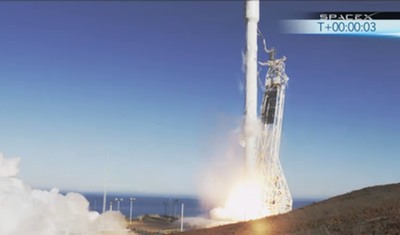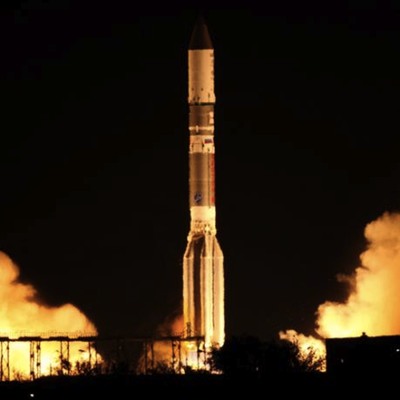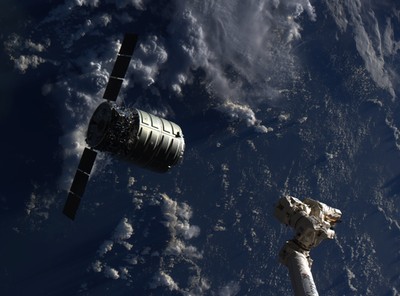Super space Sundayby Jeff Foust
|
| “You have to be patient if you want to see good things happen,” said Culbertson. “Sometimes it just takes that amount of time to get that to happen… but in the end it is worth it.” |
Instead, something even more remarkable happened. Over the course of less than 12 hours on Sunday, that Cygnus spacecraft launched earlier this month arrived at the International Space Station, while two launches delayed from earlier in the month—the first SpaceX Falcon 9 v1.1 launch and the return to flight of the Proton rocket—took place. While sports fans spent much of Sunday following the last day of Major League Baseball’s regular season or another week of National Football League action, space aficionados enjoyed what some dubbed “Super Space Sunday.”
Cygnus closes out the COTS program
When the Antares rocket successfully placed the Cygnus spacecraft into orbit on September 18, the plan was for Cygnus to rendezvous with the ISS the following Sunday, September 22, gradually approaching the station until it reached a distance of 10 meters. The station’s Canadarm2 robotic arm would then grapple the spacecraft and berth it to the station, as it does SpaceX’s Dragon and the Japanese HTV cargo spacecraft.
In the early morning hours last Sunday, though, a glitch derailed those plans. Orbital said that when Cygnus established a data link with the ISS, “some of the data received had values that it did not expect, causing Cygnus to reject the data.” The company later said that Cygnus had encountered a “GPS roll-over discrepancy” that could be fixed with a software patch that changed just one line of code on the spacecraft’s computers. Rendezvous was first rescheduled for Tuesday, then delayed until the weekend to accommodate Wednesday night’s arrival of three new ISS crewmembers on a Soyuz spacecraft launched earlier that day.
When Orbital attempted the rendezvous again in the early morning hours this Sunday, September 29, there were no problems. Orbital spacecraft controllers put Cygnus through its paces, gradually approaching the station and demonstrating, among other capabilities, the ability to stop and retreat. The process went so smoothly that the rendezvous ended up ahead of schedule: the ISS crew, using Canadarm2, grappled Cygnus at 7:00 am EDT, 15 minutes ahead of schedule (and, as it turned out, during a gap in live video coverage from the station.) The arm then berthed the spacecraft to the station about an hour and 45 minutes later, also ahead of the original schedule.
As a post-berthing press conference late Sunday morning, NASA and Orbital officials alike celebrated the successful arrival of Cygnus. “I couldn’t be happier to be here today for the day we’ve waited for,” said Alan Lindenmoyer, manager of NASA’s Commercial Crew and Cargo Program, which oversees the Commercial Orbital Transportation Services (COTS) effort of which Cygnus is a part.
As Lindenmoyer’s comment suggested, NASA and Orbital, among others, had been waiting for this day for some time. Under Orbital’s original COTS award in 2008, the company planned to fly this demonstration mission to the ISS at the end of 2010, but various delays, including with the construction of the launch site at Wallops Island, Virginia, pushed the mission back nearly three years. (The other COTS partner, SpaceX, also experienced significant delays in performing its planned test flights, completing its final COTS milestones last May.)
“You have to be patient if you want to see good things happen,” said Orbital executive vice president Frank Culbertson at the press conference. “It’s been hard for many people, particularly in the management chain, our investors, and everywhere else, to be patient that this would work out. Sometimes it just takes that amount of time to get that to happen… but in the end it is worth it.”
| “It was a great day,” Musk said of the Falcon 9 launch. |
Now, Orbital and NASA are focused on the in-flight operations of Cygnus. Hatches between the spacecraft and the ISS opened early Monday, and the station crew will be start unloading the 700 kilograms of cargo that Cygnus carried to the station on this demonstration flight. (Culbertson noted at the press conference that this cargo is more than any previous commercial vehicle that visited the station, a subtle tweak of SpaceX, who has sent three Dragon spacecraft to the ISS to date.) The relatively light load of the Cygnus—upcoming missions will carry 1.5 to 2 tons of cargo—should allow the crew to unpack it, then load it with garbage, and still depart the station on the October 22, as planned before the one-week delay in berthing.
The Cygnus mission won’t officially be over until the spacecraft depart the station and reenters the atmosphere, where it will burn up, but NASA has all but declared the mission a success already. That would clear the way for Orbital to perform the first of eight contracted cargo missions to the ISS as soon as this December. “They’re good to go,” Lindenmoyer said. “They've got a demonstrated system that certainly can deliver.”
The Orbital team, Culbertson said, was “very excited, very tired, and just thrilled to be where they were.” There was also, he said, an appreciation by them of the difference between this program and other, more conventional, satellite and launch vehicle effort. “They came up to me and said, ‘This is different. This is really amazing, and I am so happy to be a part of this.’”
 The first Falcon 9 v1.1 lifts off from Vandenberg Air Force Base in California, in this screen capture from the SpaceX webcast of the launch. (credit: SpaceX) |
A new Falcon takes flight
While Culbertson and Lindenmoyer were speaking at Orbital’s facilities outside Washington, DC, across the country, SpaceX was in the final stages of the countdown for the first launch of its upgraded “v1.1” Falcon 9. That launch had slipped for months as the company finalized work on the rocket; a launch attempt in mid-September was postponed after encountering an issue during a static fire test on September 12, pushing the launch to the end of the month because of previously-scheduled missile tests at Vandenberg Air Force Base in California.
Because the Falcon 9 v1.1 was, in many respects, a new launch vehicle, with upgraded Merlin 1D engines and a stretched first stage, it was reasonable to expect last-minute, or even last-second, glitches that would delay the launch. However, throughout the final stages of the countdown, SpaceX officials said during the launch webcast, the vehicle was in good condition, as was its satellite payload, while the launch range and weather were also cooperating.
And, at the beginning of the launch window at 9 am PDT (12 noon EDT), the Falcon’s nine first-stage engines roared to life and the vehicle left the pad. While onboard cameras suffered communications glitches that caused the video to regularly drop out, the video that did come down, along with other telemetry, showed the launch going as planned, through shutdown of the rocket’s second stage engine in orbit. (SpaceX ended their webcast before separation of the satellite payloads, and was also generally stingy with data about the launch, particularly when compared to the steady stream of online updates provided by Orbital earlier in the day tracking Cygnus’s arrival at the ISS.)
In a phone teleconference with reporters three hours after launch, SpaceX CEO Elon Musk confirmed that the launch was indeed a success. “It was a great day,” he said, confirming that all the satellites onboard the Falcon 9—Canada’s CASSIOPE space science and technology demonstration spacecraft and several secondary smallsats—deployed as planned. The first and second stages, he said, performed “slightly better than expected.”
There were a couple of issues the Falcon 9 encountered after satellite deployment. Musk said that SpaceX planned to fire the second stage’s single engine again after satellite deployment. “We initiated relight, and then the system encountered an anomaly, and did not complete the relight,” he said. That restart wasn’t needed for this mission, but enhances performance for launches of commercial geosynchronous orbit satellites. “We believe we understand what that issue is, and should have it addressed in time for the next flight of the Falcon 9.”
A more daring experiment was an effort to recover the Falcon 9 first stage. After stage separation, the first stage ignited three of its nine engines to slow its entry back into the atmosphere. That burn and the entry went as expected, he said. As the stage approached the ocean, it attempted to relight one engine. However, Musk said that the stage started spinning—likely because of atmospheric torque—beyond the ability of the stage’s attitude control thrusters to mitigate. That caused the remaining propellant in the stage to “centrifuge” on the sides of their tanks, shutting down the engine.
That premature shutdown caused the stage to hit the water hard, he said, preventing an intact recovery. He said later in the call that they were able to recover significant portions of the stage, including the interstage section and parts of the engine bay. “There’s some pretty cool video” of the stage reentry that was also recovered, Musk said, and should be posted later this week.
| “If things go super well,” Musk said of SpaceX’s Falcon 9 recoverability efforts, “then we will be able to refly a Falcon 9 stage before the end of next year.” |
Despite the failure to recover the stage intact, Musk said the flight helped demonstrate that it should be possible for SpaceX to recover, and eventually reuse, those first stages in the near future. “The most important thing is that we now have all the pieces of the puzzle,” he said, adding the experience of this flight with previous tests of their Grasshopper test vehicle, which has demonstrated vertical takeoff and landing in several tests from the company’s Texas test site. “We have all the pieces necessary to achieve a full recovery of the booster stage. I think we’ll achieve that next year.”
In the near term, SpaceX is focused on its next two launches, of commercial communications satellites for SES and Thaicom. SES-8 is slated for launch from Cape Canaveral in October, Musk said, provided they understand the issues with the shutdown of the upper stage engine, while Thaicom 6 will launch from the Cape before the end of the year. Musk said SpaceX won’t attempt booster recovery on those missions in order to give the maximum performance to the payloads.
SpaceX will next try to recover the Falcon 9 booster on the fourth launch of the v1.1 version, carrying a Dragon spacecraft on a commercial cargo mission to the ISS, a mission now planned for February. That rocket may also be equipped with landing legs: while a return to the launch site on land isn’t expected, the legs may help limit the spinning of the stage that caused the engine shutdown before splashdown. Musk said SpaceX is working with the Air Force and the FAA to identify potential landing sites for Falcon 9 first stages on the Cape, such as on the far eastern tip of the cape.
“If things go super well,” he said near the end of the press conference, “then we will be able to refly a Falcon 9 stage before the end of next year.”
 The Proton M carrying the ASTRA 2E satellite lifts off from the Baikonur Cosmodrome in the early morning hours Monday local time, or late Sunday afternoon US East Coast time. (credit: ILS) |
Proton makes its return
The last major milestone of Sunday took place about two hours after Musk concluded his post-launch press conference. About 10,000 kilometers from Vandenberg, a Proton rocket stood on the launch pad at the Baikonur Cosmodrome in Kazakhstan, about to launch the ASTRA 2E communications satellite for SES. That itself is not remarkable—the Proton launches several commercial satellites a year—but this launch was coming nearly three months after the previous Proton flew out of control seconds after liftoff, crashing into the ground and destroying itself and its payload of GLONASS navigation satellites.
This return to flight of the Proton, though, met a more fortunate fate. The Proton lifted off on time at 5:38 pm EDT (3:38 am Monday at Baikonur) and soared into the darkness. A little over nine hours later, after five planned burns by the rocket’s Breeze-M upper stage, ASTRA 2E was released into its planned orbit.
| In almost any other mode of transportation, having in effect two departures and one arrival at a port of call, so to speak, on the same day worldwide would be noteworthy for the level of activity—the absence of activity, that is. |
During the webcast coverage of the launch, and the later press release, officials with International Launch Services (ILS), which markets the Proton commercially, and its customers danced around the fact that this was a return-to-flight mission, making only oblique references to challenges and delays for this particular launch. “We thank the individual teams at SES, Astrium, Khrunichev and ILS for their commitment to launch success,” said ILS president Phil Slack in a post-launch press release. “Most of all we thank SES for their trust in ILS and Khrunichev to support their plans for expansion.”
That launch capped off an unusually active day for the space industry. It’s rare enough to have two launches in the same day, but to have a first launch of a new new rocket along with the return to flight of an existing one, in addition to the first arrival of a new cargo spacecraft at the ISS, all on the same day, made it a “super space Sunday.”
Still, some perspective is useful here. In almost any other mode of transportation, having in effect two departures and one arrival at a port of call, so to speak, on the same day worldwide would be noteworthy for the level of activity—the absence of activity, that is. Perhaps someday we’ll look back at Sunday and not marvel at the level of activity, but instead marvel at the fact that we found just two launches and one berthing in the same day so noteworthy.
